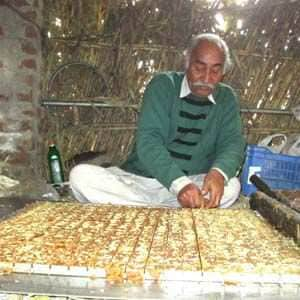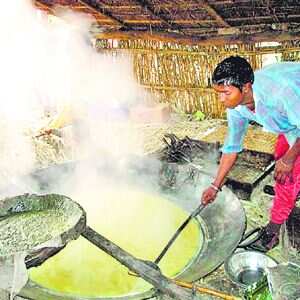Sugarcane growers take on migrant labour in gur-making business
Thanks to the district administration, local sugarcane growers are ready to take on migrants from UP and Bihar, who come to Punjab every year during cane-harvesting season and return with handfuls of profit from gur-making business.
Thanks to the district administration, local sugarcane growers are ready to take on migrants from UP and Bihar, who come to Punjab every year during cane-harvesting season and return with handfuls of profit from gur-making business.

The farmers, who had almost 'surrendered' to the migrants, are once again back to making what is known as the 'ultimate dessert' of Punjabis.

To encourage farmers set up jaggery-making units, also called mini sugar mills, the district administration has, under the Innovation Fund Scheme, formed 14 self-help groups (SHGs).
Members of the SHGs were taken on a three-day training programme at Lucknow-based Indian Institute of Sugarcane Research (IISR).
Each SHG has been provided with a cane-crushing and gur-making unit. 90% of the total cost was paid by the government and the rest by the SHGs.
The units have become operational with the advent of the cane harvesting season. This year the area under sugarcane has increased to 21,000 hectares from the last year's 19,000 hectares. The minimum support price (MSP) is Rs 290 per quintal.
For better remuneration and assured marketing, Markfed has taken upon itself the task of purchasing the finished product from the producers through FAPRO (Farmers Produce Promotional Society). The agency is buying plain gur @ Rs 45 per kg and the spiced up variety at Rs 52 per kg. The farmers have been imparted training on cube-packing of gur which makes it more attractive and easy to consume.
"Gur has considerable demand for household consumption. I have opted for gur-making because it saves me from manipulation at the hands of millers and middlemen if I were to sell sugarcane," said Narinder Singh, member of a SHG in Ajjowal.
Another cane-producer Har Prem Chand of Ghugial village claimed to supply nearly one quintal gur to Markfed daily. He has sown sugarcane over 100 acres and plans to increase the area.
"Gur contains essential minerals which make it an ideal sweetener. If sugarcane is grown purely on organics and is manufactured by using biological clarificants, its nutrient value is enhanced further," said agriculture officer Dr Chaman Lal Vashisht.

"Golden clumps of gur available at roadside gur-making units look very tempting but they are not as good from health point of view.
IISR research has found that very harmful chemicals like acetone, formalin are used by these manufacturers to make their product more enticing," said agriculture expert Dr Gurbax Singh.
To make jaggery, the cane is crushed in generator-operated machines and collected in a cement tank. A drain then takes it to a kadai (pan) at the furnace-end. Once the juice is heated to the required temperature, it is transferred to the second pan and cleansed of impurities. The clear syrup then gets concentrated and after the required consistency is reached, it is transferred to another pan. The semi-solid product is then transferred to a flat platform or mould and shaped into various forms. One round uses up around three quintals of sugarcane and produces 40 kg of gur. In the peak season, machines work round-the-clock and produce about 15 quintals of gur everyday.



